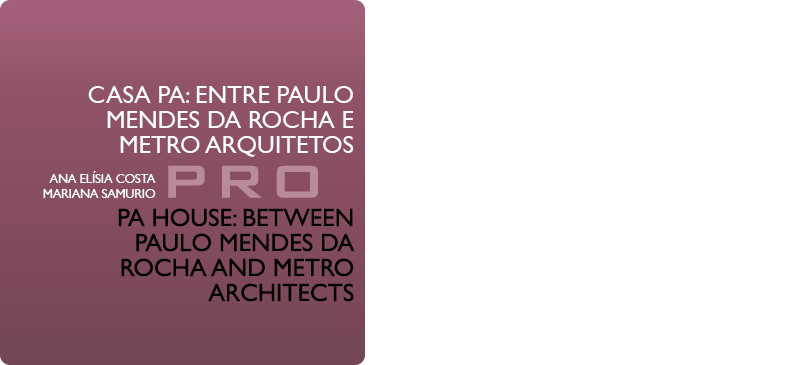
How to quote this text: Costa, A.E. and Samurio, M.R., 2016. PA House: between Paulo Mendes da Rocha and Metro Architects. V!RUS, [e-journal] 12. Available at: [Accessed 00 Month 0000].
Ana Elísia Costa is Doctor in Architecture and Urbanism and Adjunct Professor at the Federal University of Rio Grande do Sul, UFRGS. She studies Architectural Design and Architectural Heritage.
Mariana Rodrigues Samurio is undergraduate researcher on Architecture and Urbanism at the Federal University of Rio Grande do Sul, UFRGS. She studies Brazilian contemporary houses.
ABSTRACT
In 2003, the PA House was built in São Paulo, designed by Metro Arquitetos Associados, office founded in 2000, and Paulo Mendes da Rocha, who graduated in 1954. The house gains importance because references and practices from two different generations of architects were blended in it. Potentially, it can be considered a 'radical' work, once it embodies a dialectical movement with modern ideals references and, at the same time, its negation or overcoming. To measure this 'hybridization or radicalism’’, the concept of 'type' is used in architecture and the way it became to be used in the modern design conception. More than a design pre-figuration, the type started to be adopted as a formal structure open to investigations that allow deformations and overlays incorporations of types or 'fragment of types’’, already tested in previous designs. Due to this procedure, in a sequence of an architect’s designs, it is possible to identify a 'mother type' and the interference of a model to build another, mainly through the arrangement and reuse of 'wing-types' and the insertion of irregular composition elements (stairs and hydraulic cores), whose function and proportion promotes or prevents the free design of the plan. Based on that discussion, the paper aims to identify how houses built before the practice of Mendes da Rocha and Metro interfere in the PA House design, understanding this analysis as a privileged procedure to discuss the design as a reflective practice.
Keywords: Modern Architecture, Contemporary Architecture, Residential Architecture.
Introduction
The word 'radical', conceptually, can characterize something that departs from what is traditional or usual, something extreme. Contradictorily, the word may also relates to an origin, root or something unique that comes from a root. Radicalize, thus, may involve a dialectical movement of returning to the origins and, simultaneously, denying them.
In this dual context, the paper aims to investigate contemporary works that, in different levels, seek modern ideas references and, at the same time, overcome them, stimulating reflections on the contemporary world, its dissonances and consensus.
Special attention is given to the PA House that, in 2013, was built in São Paulo, designed by Metro Arquitetos Associados office, in partnership with the architect Paulo Mendes da Rocha. Metro Office is from São Paulo and was founded in 2000 with a team composed originally by the architects Martin Corullon (USP - 2000), Gustavo Cedroni (FAAP - 2001) and Anna Ferrari (Mackenzie - 2000). In 2014, Anna Ferrari left the team and, in 2016, the participation of two new members was announced - Helena Gentleman (UFRGS - 2008) and Marina Ioshii (USP - 2013). With a wide production, in 2010, the team was chosen by AU Magazine as one of the twenty-five offices that will set up the 'new generation of Brazilian architecture'. Paulo Mendes da Rocha’s profile almost needs no introduction due to his production and projection in the national and international architecture scene, being appropriate to point out that in 2006 the architect received the most prestigious award in the world of architecture - the Pritzker Prize. The specific study of this house deserves attention because it involves two generations of renowned Brazilian architects and that, hypothetically, hybridize or radicalize in this work their references and practices. This work is a partial production of the research 'Brazilian Contemporary Houses: rule and typological transgression in the domestic environment', developed from 2014 by five universities - UFRGS, UFPB UFPel, UCS, UEG (Available at: ).
To measure the 'hybridization or radicalism' of this house, the concept of type in architecture is used. The concept of type being studied in this paper is the classic one, written by Quatremère de Quincy in the late eighteenth century. For him, the type is a concept capable of elucidating the 'hidden' reason in architecture, based on the work’s nature and aesthetic satisfaction. Thus, the idea of type approaches a Platonic ideal, '[...] something permanent and complex, a logical statement that comes before the form and that makes it' (Rossi, 1995, p.25). This hidden reason is manifested through the permanence of certain building’s characteristics throughout history. As something abstract, the type cannot be confused with a model, which can be materialized and repeated; it is, instead, a principle which serves as a rule for a group of models over time. More clearly, Aldo Rossi (1995) explains that the type is a kind of nucleus which the objects cluster and coordinate around, so that, then, they can suffer consequences and formal variations that they are susceptible.
The distance or breach of this type is what promotes the 'extreme or radical' object, procedure strongly linked to the modern architectural design conception. According to Rafael Moneo (1999), from the modernist movement, the type’s operationalization undergoes deep changes. The architect starts working associating a type to his/her design and, as a result, intervenes on it, either respecting it, destroying it or transforming it, through deformations and overlapping of different types or fragments of types that change the typological original configuration. Thus, the notion of type from the modern architecture assumes the role of a design guideline open to investigations, which makes their study more challenging and, perhaps because of that, more necessary.
In this investigative universe, arrangements of zones or sectors can be understood as fragments of types, which, as previously tested, are replicated in new designs, whose 'assembly' seeks a better adaptation to the new context (Martí Aris, 1993). Thus, the final result is a flexible typological structure that allows coordination of various design solutions.
Due to this procedure, in a series of designs of the same architect or office, it is possible to identify what Martí Aris (1993) and Rafael Moneo (1999) define as 'typological series.' The typological series is the relationship that the type, as a common formal structure, establishes in a set of works. In the typological series, it is possible to identify the 'mother type' that guides a series continuity, as well as analyze how a model is able to interfere in the construction of another.
Among models developed by the same office, draws attention to how the arrangements of the zones are established and reused in new projects. In the zones, it is important to highlight the strategies of insertion of irregular composition elements, such as stairs and hydraulic cores - bathrooms, kitchen, laundry area - whose function and proportion favors or prevents the free design of the plan and the project`s rationalization (Martinez, 2000).
In modernism, according to Martinez (2000), the insertion of irregular composition elements happened in recurrent ways, notably: 1) insertion of these elements between regular ones (Fig. 1a); 2) insertion of these elements in zones in the plan`s boarders, favoring the integration of regular elements and the configuration of the plan’s free design or flexible plan (Fig. 1b); 3) internalization of these elements in the plan, creating an internalized core and, sometimes, a sculptural core (Fig. 1c).

Fig. 1: Insertion of irregular composition elements in the Modern Houses: (a) Guilherme Brandi House, 1952. Petrópolis. Sergio Bernardes; (b) Hildebrando Accioly House, 1950. Francisco Bologna; (c) Chiyo Hama House, 1967. Ruy Ohtake.
Source: (a) Anon., 1955, p. 451; (b) Anon., 1952, p. 18-21; (c) Zein, n.d. Available at: . Interventions on the base: by the authors.
In the context of this discussion, will be addressed the design for the PA House. Would the PA House design a 'hybridized' model, which suffers the 'interference' of models produced by Mendes da Rocha and the own Metro office? Identifying how Paulo Mendes da Rocha`s and Metro office`s houses interfere in the PA House design is the main objective of this article. By identifying modern architecture`s production reverberations and derivations in contemporary Brazilian production, this study becomes relevant.
PAULO MENDES DA ROCHA’S INVESTIGATION
Between 1953 and 1973 , five houses developed by Paulo Mendes da Rocha stand in the context of São Paulo Brutalism (Zein, 2005) - Celso Silveira Mello House (1962); Butantã House (1964-1966) and Mario Masetti House (1968), both in partnership with the architect João Eduardo de Gennaro; Fernando Millan House (1970); Francis Francis King House (1972). Out of the chronological order suggested by ZEIN (2005), the Antonio Gerassi Neto House also deserves to be mentioned (1989-1991). In this context and illustratively, five houses with compact volumes are chosen to be reviewed.
The Celso Silveira Mello House (1962), built in Piracicaba, marks the beginning of the use of the apparent concrete in Paulo Mendes da Rocha’s residential architecture of (Zein, 2005). The house’s compact volume has rectangular proportions, suffering minor volumetric subtractions in the two cross façades. In the longitudinal gables in apparent concrete, there are few openings, in contrast with the large openings on the transverse façades. On the ground floor, half-buried and in two levels, four irregular elements - kitchen, bathroom and stairs - are sprayed. On the upper floor, a central empty core, with stairs and a walkway, connects the intimate and social sectors, arranged in the two longitudinal ends of the volumes. Bathrooms are internalized in the intimate sector, taking on sculptural forms; and, in the social sector, the toilet along with the living room configure a block that compartmentalized the sector’s free design of the plan (Fig. 2).
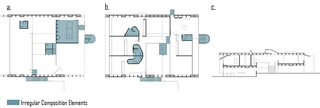
Fig. 2 (a, b, c): Insertion of irregular composition elements in the Celso Silveira Mello House, 1962. Piracicaba. Paulo Mendes da Rocha.
Source: Zein, n.d. Available at: . Intervantions on the base: by the authors.
The Butantã Houses (1964-1966) are two similar houses, with variations in plans and openings, which were built on the same site in São Paulo, one for the architect and another for his sister, Lina C. Secco. Volumetrically, the houses are configured as pure prisms with square base proportions, supported by pilotis set up by four columns of recessed facades. Decomposing, each of these volumes is configured by blind gables of reinforced concrete which 'surround' the base floor, which is treated as an independent body. In the half-buried pilotis, the irregular elements are grouped into a cylindrical volume, with an almost sculptural expression. The two houses floor plans are separated in three, being defined in zones: the social sector, which opens widely to the outside; the intimate sector, without its classical circulation; and a balcony, for which the bedrooms open to. In the intimate area, irregular composition elements - bathrooms and closets - are grouped linearly and internalized, making it possible for the bedrooms and living room to be placed in the boarders. With the same goal of releasing the plan, the kitchen and the stairs are placed on its periphery (Fig. 3) (Fracalossi, 2014; Acayaba, 2011; Noble, 2007; Zein, 2005; Lemos and Corona, 1983).
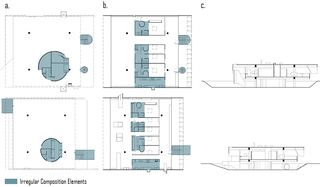
Fig. 3 (a, b, c): Insertion of irregular composition elements in the Butantã Houses, 1964-1966. São Paulo. Paulo Mendes da Rocha e João Gennaro.
Source: Zein, n.d. Available at: . Interventions on the base: by the authors.
It is also notable that the Butantã Houses volumetric composition, according to Zein (2005), configures variations of the same theme, called by her as 'apartment-house' - compact volume with an almost square base shape supported by pilotis. In this volume, two parallel gables are more open and two are more closed. Internally, it’s possible to observe that the program is organized in three transverse parallel zones, with the social sector and the intimate sector occupying the two extremes. These characteristics can also be seen in the Bento Odilon Ferreira House in Goiânia (1963) and in the Francisco Cardoso Malta House in São Paulo (1964).
In the neighborhood of Pacaembu, in Sao Paulo, the Mario Masetti House’s (1968) volume assumes rectangular proportions, just like in the Celso Silveira Mello House, the last one supported by pilotis, as well as in the Butantã Houses. Thus, it is possible to observe the start of a design process in which previous models and/or the hybridization of them begin to interfere in the construction of another model. The pilotis rest on a platform with a half-buried volume, and it is configured by four columns, two of them away from the façade and two built in the axis of one of the side gables, but partially exposed on the façade. The prism treatment obeys the strategies already noted above - two more closed longitudinal gables that are opposed to the more open transverse walls, with the plan extension of the roof and the side gables protecting the transverse openings, which suggests visually volumetric subtractions (Fig. 4).
As in the Celso Silveira Mello House, a central element connects the intimate and the social sector, arranged in the two longitudinal ends of the volume. In this case, however, the central element is reduced, assuming the feature of a gigantic corridor which is emphasized by the overhead lighting. With this solution, the two staircases that connect the floors are externalized, as in the Butantã Houses. In the intimate sector, unlike previous solutions, the bathrooms configure a transverse zone that occupies the volume’s periphery, which gives them direct ventilation and lighting. The solution restricts the rooms’ visual contact to the outside, interacting directly with the central corridor. In the social sector, the kitchen assumes a peripheral position, which ensures the large living room shape, such as in the in Butantã Houses (Fig. 4) (Acayaba, 2011; Zein, 2005; Xavier, Lemos and Corona, 1983).
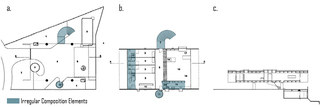
Fig. 4 (a, b, c): Insertion of irregular composition elements in the Mario Masetti House, 1968. São Paulo. Paulo Mendes da Rocha.
Source: Zein, n.d. Available at: . Interventions on the base: by the authors.
The Fernando Millan House (1970), built in São Paulo, still keep the rectangular proportions observed in two houses previously analyzed. As in the Celso Mello House, the sectors arrangement occurs from a central void that absorbs the stairs and the walkway. In addition, in this case, there is no pilotis and the house is half-buried in a steep site. On the ground level, cut by a curved wall, irregular elements are grouped linearly on the volume’s outskirts, creating parallel zones in the central void. On the first floor, the intimate sector’s bathroom and the social sector’s bathroom are part of the regular elements, receiving direct lighting and ventilation from the exterior and fragmenting the suggestion of the design of a free plan, where the living room and the bedrooms are modularly inserted (Fig. 5) (Zein, 2005).
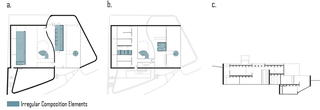
Fig. 5 (a, b, c): Insertion of irregular composition elements in the Mario Masetti House, 1968. São Paulo. Paulo Mendes da Rocha.
Source: Zein, n.d. Available at: . Interventions on the base: by the authors.
The Gerassi House (1989-1991), as the Butantã Houses, the house is built in São Paulo and is organized in a pure prism square base supported by pilotis. However, the pilotis here is configured by six columns that are highlighted in the volume. In the façades where the columns are exposed, the full dominates the empty and, in the free façades, large windows are opened supported by beams that support the floor slabs and the roof.
On the ground floor, it is observed two isolated volumes - bathrooms and vertical circulation. On the first floor, the tripartite configuration previously observed is abandoned and compartmentalized cores are dispersed through the plan. A core consists of service sector`s rooms, toilets and the staircase that, in this case, loses the feature of single element and/or sculptural as noticed in the previous solutions. The other two cores, perpendicular to the first, consist of bathrooms arranged between the living room and the bedrooms. These last two cores fragment themselves by the need to expand the master suite dimensions, a solution that helps to set up a kind of intimate hall delimited by the central skylight. On the other hand, this hall`s arrangement can also suggest that the architect seeks to rescue the hierarchy between the intimate and social sectors, whose separation was more culturally assimilated (Fig. 6) (Fracalossi, 2015).
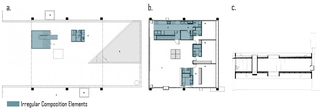
Fig. 6 (a, b, c): Insertion of irregular composition elements in the Gerassi House, 1991. São Paulo. Paulo Mendes da Rocha.
Source: Fracalossi, 2015. Interventions on the base: by the authors.
In the five houses analyzed, it’s possible to observe a design strategy continuity - shaping spaces from a pure prism. Chronologically, this strategy about variations that are resumed alternately - volumes arrangements of rectangular proportions, with the organization made from a central void (Celso Silveira Mello - 1962, Fernando Millan - 1970) and arrangements of quadratic proportions volumes, supported by pilotis (Butantã - 1964-1966; Gerassi - 1989-1991). The Mario Masetti House (1968) represents an example of hybridization of these two main schemes, assuming a configuration of a volume with rectangular proportions, with the organization made from a central axis, supported by pilotis.
In four of the houses, the tripartite plan and is observed and, in three of them, the irregular composition elements are internalized, releasing the façades for the most used rooms - bedrooms and living rooms. However, procedurally, the Gerassi house (1991) reveals that there is a break in the rigid tripartite plan arrangement, in the sculptural arrangement of the staircase and the concentrated arrangement of hydraulic cores.
METRO AND THEIR HOUSES
If the five Mendes da Rocha’s houses fall back on to pure square or rectangular base volumes, the formal vocabulary used in the Metro houses is more diverse. In the office website - http://www.metroo.com.br/ - only six houses produced between 2003 and 2001 are published, out of which one does not have sufficient data for analysis (St. Helena - 2014) and one is a renovation (SMA - 2016). In the four remaining houses, there is an initial adoption of compact volumes (PA - 2003; SPC - 2009) and, subsequently, additives volumes (LP - 2012; BN - 2015). Anyway, in most of the houses, the use of large blind surfaces opposed to glass surfaces still dominates, as seen in the works of Paulo Mendes da Rocha.
As for the arrangement of irregular composition elements, there is also a greater solutions diversity in the Metro Office designs, highlighting three main schemes that refer to what was already been discussed in modern houses (Fig. 1). The first scheme refers to the one in which the irregular composition elements are internalized in the plan, as can be illustrated by the PA House (2003) and RCM (2009), as well as in the Mello, Butantã and Gerassi houses, by Mendes da Rocha, already analyzed. (Fig. 7a). In the second scheme, the irregular elements are grouped in peripheral zones, enabling the other zone`s configuration as a free plan and/or modulated. Illustrates this scheme the LP House (2012), built in São Paulo - SP. In the LP House, service area, kitchen and bathrooms configure a longitudinal and peripheral volume that is opposed to the main volume, where living rooms and modular bedrooms are arranged linearly, in order to have the best visuals and best solar orientation. (Fig. 7b). Finally, in the third scheme, the irregular elements are placed in direct interface with the regular elements (bedrooms and living rooms). This scheme is illustrated in the BN House (2015), in which individual volumes are gathered around a central space and the bathrooms are isolated in each of the volumes, next to the bedrooms. This last house is the one has the most different solution compared to the other houses studied in this paper (Fig. 7c).
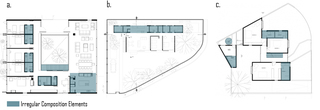
Fig. 7: Insertion of irregular composition elements in the Metro Architects office's houses: (a) RCM House, 2009. Ibiuna - SP; (b) LP House, 2012. São Paulo - SP; (c) BN House, 2015. São Paulo - SP.
Source: (a e b) Samurio, 2015; (c) Metro, n.d.b Available at: . Interventions on the base: by the authors.
Chronologically, it is perceivable that the first two houses of Metro - PA (2003) and RCM (2009) - are closer to the solutions used by Mendes da Rocha, either by their compact volumes, either by the irregular elements of the composition concentration and internalization. In the other two houses - LP (2012) and BN (2015), the solutions adopted suggest exploring other typological arrangements, with a growing volume fragmentation and hydraulic cores dispersion in the plan.
THE PA HOUSE: PAULO MENDES DA ROCHA MEETS METRO
The PA House was designed in 2003, in partnership with the architect Paulo Mendes da Rocha. In general terms, the house is introduced this way by the office:
The house, which has a volume with two levels with an offset from the street quota, has a structure in reinforced concrete molded on site and seals in concrete blocks.
In the basement there are located the service dependencies and a lounge.
On the ground level is located the water surface, a covered area for car parking, a restroom and the access to the stairs and elevator, the houses’ main entrance.
On the first floor is located the living room and dining room, kitchen, laundry room and a bedroom. On the second floor is located the bedrooms with their bathrooms. On the roof, with a pre-cast concrete floor, there is the hot and cold water tanks and the external air-conditioning machines.
The vertical circulation has a main staircase in concrete and an external metal uncovered staircase, used for service access (Metro, n.d.a)
A closer analysis of its volumes reveals a rectangular prism supported by pilotis, formed by six pillars recessed from the façades. This way, the two arrangements observed in the Paulo Mendes da Rocha’s houses are hybridized - the rectangular prism, which was before based on the ground, and the use of pilotis, formerly associated with prisms of square base. Therefore, there is a typological relationship with the Mario Masetti House (1968). Again, the façade treatment refers to the treatment of the more closed longitudinal gables, opposed to the transverse glazed surfaces. As the glazed surfaces does not open to the garden, the set is completed by a large slab-terrace, which parallel and along the main volume opens the first floor to the garden that is carefully designed (Fig. 8).

Fig. 8: Prismatic volume on pilotis and slab-terrace in the PA House, 2003. São Paulo - SP. Metro Architects and Paulo Mendes da Rocha.
Source: Samurio, 2014.
In plan, the use of a rectangular prism does not impose the tripartite arrangement with a central void or axis, as the Mello, Millan and Masetti Houses from Paulo Mendes da Rocha. Here, the volume’s prismatic geometry and its relationship with the garden impose the compositional elements arrangement in the plan’s longitudinal direction, whether the bathrooms and circulations vertical core, or the void from the pilotis on the ground level and still, the large living room of the first floor, which differs from all solutions studied previously (Fig. 9).
On the second floor, the longitudinal arrangement of the first two floors is tensioned by the transverse layout of the bedrooms in the two extremes of the volume, partially justified by the irregular composition elements fragmentation. It is believed that the non-coincidence of hydraulic cores between the floors derives from the tension between the axes that organizes these floors - longitudinal (ground and first floor) and transverse (second floor) (Fig. 9).
It should be noted that the main staircase, which remains constant on all floors and if possible linked to other irregular composition elements, assumes a modest formal expression in this design. Creating a core with the elevator, the PA House staircase stands out in a central void or projects externally in relation to the 'walled box', thereby assuming a strictly functional character, as in the Gerassi House (Fig. 9).
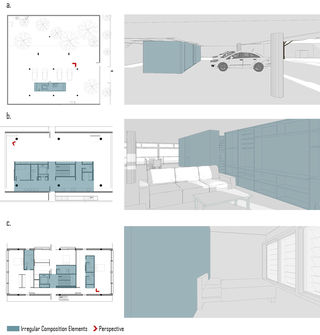
Fig. 9 (a, b, c): Insertion of irregular composition elements in the PA House, 2003. São Paulo - SP. Metro Architects and Paulo Mendes da Rocha.
Source: Samurio, 2014.
The solution used on the PA House’s second floor may have been influenced by solutions already tested along Paulo Mendes da Rocha’s career, especially in the Gerassi House, where the irregular elements of the composition are not rigidly grouped or organized in zones. This hypothesis can be sustained by proving, through speculative graphic studies, that the third floor could have kept a more rigorous arrangement of hydraulic cores, even when maintained the rooms’ orientation. (Fig. 10).
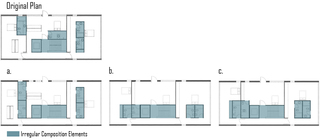
Fig. 10 (a, b, c): Hypotheses of insertion of irregular composition elements in the PA House.
Source: Samurio, 2014.
THE NEXT CHAPTER OR CONTAMINATION IN RCM
Seven years after the experience of the PA House, in 2009 and in Ibiúna - SP, Metro designs the RCM House. This house can be understood as a PA House’s 'reverberation' or partnership between Metro and Mendes da Rocha, since solutions previously used by him are hybridized again here. The square base prism supported by pilotis, as in the Butantã and Gerassi Houses, has a similar spatial organization than the one observed in houses with rectangular base volumes (Mello, Millan and Masetti), in other words, there is a central void that separates the social and intimate sectors and that absorbs the staircase (Fig. 11).
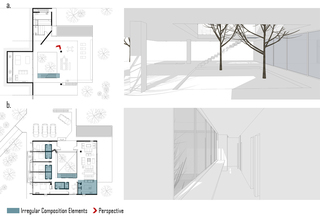
Fig. 11 (a, b, c): Insertion of irregular composition elements in the RCM House, 2009. São Paulo - SP. Metro Architects
Source: Samurio, 2014.
The plan’s tripartite division seen in Paulo Mendes da Rocha’s work is relativized here, being part of the intimate sector aligned with the central void, without, however, compromising its hierarchy in the spatial arrangement. Consequently, the hydraulic cores, while still grouped and internalized, gain a provision with greater fluidity, as noted in the Gerassi and PA Houses, both with participation of Mendes da Rocha.
CONCLUSION: A FAINT PROCESS OF RADICALIZATION
Thus, the PA House and, later, the RCM House, outline hybridizations and re interpretations of solutions previously used by Paulo Mendes da Rocha. Rectangular base prisms gain pilotis and take common spatial arrangements as the square floor plan houses. Square base prisms gain common spatial arrangements as the houses with rectangular plans. Irregular composition elements are internalized, sometimes configuring rigid clusters, others, diluting themselves along the plan in order to promote a better resolution to the design problem. Stairs or are omitted as expressive architectural element in the set, or sometimes gain expression in the middle of the central void.
In the presented examples’ analysis, what Martí Aris (1993) and Rafael Moneo (1999) define as 'typological series' was reinforced. Between Paulo Mendes da Rocha’s houses, and the PA and the RCM Houses from Metro, there is a common formal structure that guides the continuity of a series, in which a model interfere in the construction of another, even if not in a linear mode (Fig. 12).
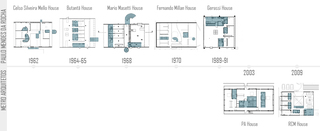
Fig. 12: Timeline with housing designs from Paulo Mendes da Rocha and the Metro Architects Office in which there are square and rectangular compact plans arrangements. Highlighted, arrangement of irregular composition elements.
Source: Samurio, 2014.
The architects start working associating a type to their design and, in sequence, make changes to this type, transforming it through the use of types’ fragments already tested in previous designs. Thereby, the typological structure used in the design of the PA and RCM Houses are flexible, allowing the coordination of various design solutions.
Through this study, it is possible to identify, from the typological point of view and less centered on figures of Paulo Mendes da Rocha and Metro Office, reverberations and derivations of the modern production in the Brazilian contemporary production. It is, however, a subtle process of 'radicalization'. If radicalize involves a dialectical movement of returning to the origins and denying it, it is noticed here a stronger comeback to modern references than a denial of it. This, however, is not the only strategy to guide the new Brazilian generations' production that, according to Zein and Bastos (2010), has bowed to modern heritage and, at the same time, seek its own expression that should be studied better.
REFERENCES
Acayaba, M. M., 2011. Residências em São Paulo: 1947 - 1975. São Paulo: Romano Guerra.
Anonimous, 1952. Le Brésil et l'Architecture Contemporaine. L’architecture d’aujourd’hui, August, 42-43.
Anonimous, 1955. Residência em Petrópolis. Acrópole, July, 202, pp.449-452.
Fracalossi, I., 2013. Clássicos da Arquitetura: Casa Gerassi / Paulo Mendes da Rocha. ArchDaily Brasil, 6 July. Available at: [Accessed 26 June 2015].
Fracalossi, I., 2014. Clássicos da Arquitetura: Casa no Butantã / Paulo Mendes da Rocha e João de Gennaro. ArchDaily Brasil, 12 March. Available at: [Accessed 06 May 2015].
Martí Aris, C., 1993. Le variazioni dell’identità: il tipo nella architettura. Torino: Città Studio Edizione.
Martinze, A. C., 2000. Ensaio sobre o projeto. Brasília: Editora da UNB.
Metro, n.d.a. Casa PA, São Paulo, SP. Available at: [Accessed 18 January 2016].
Metro, n.d.b. Metro arquitetos. Available at: [Accessed 18 January 2016].
Moneo, R., 1999. La solitudine degli edifici e altri scriti: Questioni intorno all’architettura. Torino: Umberto Allemandi & C.
Nobre, A. L., 2007. Um em dois: as casas do Butantã, de Paulo Mendes da Rocha. Arquitextos, July, 086.01, Vitruvius. Available at: [Accessed 06 May 2015].
Rossi, A. A Arquitetura da Cidade. São Paulo: Martins Fontes, 1995.
Samurio, M., 2015. Contaminações: do encontro entre Paulo Mendes da Rocha e Metro Arquitetos. Scientific research. Universidade Federal do Rio Grande do Sul. Available at: [Accessed 18 January 2016].
Xavier, A., Lemos, C. and Corona, E., 1983. Arquitetura moderna paulistana. São Paulo: Editora Pini.
Zein, R. V., 2005. A Arquitetura da Escola Paulista: 1953-1973. Doctoral degree. Universidade Federal do Rio Grande do Sul.
Zein, R. V., n.d. Arquitetura Brutalista. Available at: [Accessed 18 January 2016].
Zein, R. V. and Bastos, M. A. J., 2010. Brasil: arquiteturas após 1950. São Paulo: Perspectiva.














